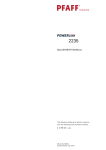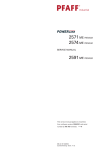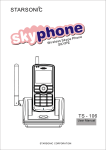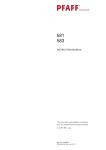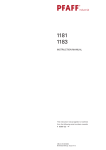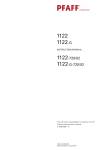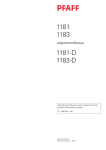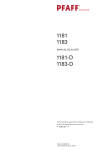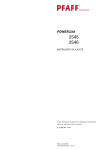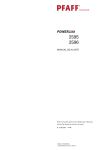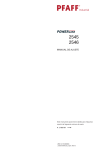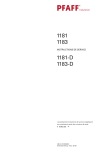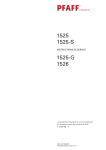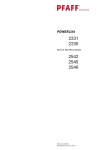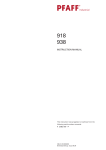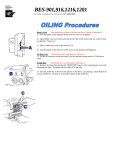Download Pfaff 574 User's Manual
Transcript
571 574 ADJUSTMENT MANUAL 591 This Adjustment Manual is valid for machines from the following serial numbers onwards: # 6 500 120 296-12-19 196/002 Justieranleitung engl. 07.12 The reprinting, copying or translation of PFAFF Service Manuals, whether in whole or in part, is only permitted with our previous authorization and with written reference to the source. PFAFF Industriesysteme und Maschinen AG Hans-Geiger-Str. 12 - IG Nord D-67661 Kaiserslautern Index Contents ................................................................................ Page 1 1.01 1.02 1.03 1.04 1.04.01 1.04.02 1.04.03 1.04.04 1.04.05 1.04.06 1.04.07 1.04.08 1.04.09 1.04.10 1.04.11 1.04.12 1.04.13 1.04.14 1.04.15 1.04.16 1.04.17 1.04.18 1.04.19 1.04.20 1.04.21 1.04.22 1.04.23 1.04.24 1.04.25 1.04.26 1.04.27 1.04.28 1.04.29 1.04.30 1.05 1.05.01 1.05.02 1.05.03 Adjustment ........................................................................................................................... 5 Tools, gauges and other accessories .................................................................................... 5 Abbreviations ......................................................................................................................... 6 Explanation of the symbols .................................................................................................... 6 Adjusting the basic machine .................................................................................................. 7 Needle position in sewing direction (on the PFAFF 571 and 591) ......................................... 7 Needle position in sewing direction (on the PFAFF 574) ........................................................ 8 Preliminary adjustment of the needle height ......................................................................... 9 Needle rise, hook clearance, needle height and needle guard (on the PFAFF 571)................. 10 Needle rise, hook clearance, needle height and needle guard (on the PFAFF 574) .................12 Needle rise, hook clearance, needle height and needle guard (on the PFAFF 591).................14 Needle position crosswise to sewing direction (on the PFAFF 571) .................................... 16 Needle position crosswise to sewing direction (on the PFAFF 574) .................................... 17 Needle position crosswise to sewing direction (on the PFAFF 591) .................................... 18 Height and stroke of the bobbin case opener ...................................................................... 19 Height of the feed wheel (on the PFAFF 571)...................................................................... 20 Height of the feed wheel (on the PFAFF 574) ...................................................................... 21 Height of the feed wheel (on the PFAFF 591)...................................................................... 22 Stitch length control eccentric ............................................................................................. 23 Stitch length scale disk ........................................................................................................ 24 Shaft crank to feed wheel drive ........................................................................................... 25 Shaft crank to roller presser drive ........................................................................................ 26 Clearance between roller presser and feed wheel .............................................................. 27 Roller presser ....................................................................................................................... 28 Stitch length on stitch length scale ...................................................................................... 29 Synchronization of roller presser and feed wheel ................................................................ 30 Retainer (only on model 574) ............................................................................................... 31 Knee lever ............................................................................................................................ 32 Needle thread tension release ............................................................................................. 33 Thread check spring (PFAFF 571 and 591) ........................................................................... 34 Thread check springs (PFAFF 574)........................................................................................ 35 Bobbin winder ...................................................................................................................... 36 Pressure of roller presser..................................................................................................... 37 Lubrication ........................................................................................................................... 38 Re-engage safety coupling................................................................................................... 39 Adjusting the edge trimmer -725/04 .................................................................................... 40 Position of the knife holder (on model 571) ......................................................................... 40 Position of the knife holder (on models 574 and 591) .......................................................... 41 Knife stroke (on model 571) ................................................................................................. 42 3 Index Contents ................................................................................Page 1.05.04 1.05.05 1.05.06 1.05.07 4 Knife stroke (on models 574 and 591) .................................................................................. 43 Cutting stroke (on model 571).............................................................................................. 44 Cutting stroke (on models 574 and 591) .............................................................................. 45 Knife position ....................................................................................................................... 46 1.06 1.06.01 1.06.02 1.06.03 1.06.04 1.06.05 1.06.06 1.06.07 1.06.08 Adjusting the thread trimmer -900/83 .................................................................................. 47 1.07 1.07.01 1.07.02 1.07.03 1.07.04 1.07.05 Adjustment of backtacking mechanism -911/....................................................................... 55 1.08 Parameter settings ............................................................................................................... 60 2 Block diagram..................................................................................................................... 61 Resting position of the roller lever / radial position of the control cam ................................ 47 Position of the thread catcher holder ................................................................................... 48 Position of the thread catcher .............................................................................................. 49 Knife position and knife pressure ......................................................................................... 50 Bobbin thread retaining spring ............................................................................................. 51 Manual cutting test .............................................................................................................. 52 Releasing the tension .......................................................................................................... 53 Linkage rod (only for the PFAFF 574) ................................................................................... 54 Needle in needle hole (only for PFAFF 571 and 591) ........................................................... 55 Coupling for roller presser drive ........................................................................................... 56 Bevel gears for feed wheel drive ......................................................................................... 57 Bevel gear play ..................................................................................................................... 58 Adjusting the magnets ......................................................................................................... 59 Adjustment 1 Adjustment Please observe all notes from Chapter 1 Safety of the instruction manual! In particular care must be taken to see that all protective devices are refitted properly after adjustment, see Chapter 1.06 Danger warnings of the instruction manual! If not otherwise stated, the machine must be disconnected from the electrical power supply. Danger of injury due to unintentional starting of the machine! Notes on adjustment All following adjustments are based on a fully assembled machine and may only be carried out by expert staff trained for this purpose. Machine covers, which have to be removed and replaced to carry out checks and adjustments, are not mentioned in the text. The order of the following chapters corresponds to the most logical work sequence for machines which have to be completely adjusted. If only specific individual work steps are carried out, both the preceding and following chapters must be observed. Screws, nuts indicated in brackets ( ) are fastenings for machine parts, which must be loosened before adjustment and tightened again afterwards. 1.01 Tools, gauges and other accessories ● 1 set of screwdrivers with blade widths from 2 to 10 mm ● 1 set of open-ended wrenches with opening sizes from 7 to 13 mm ● 1 set of allen keys from 1.5 to 6 mm ● 1 clamp (Order No. 08-880 137-00) ● 1 metal rule (Order No. 08-880 218-00) ● 1 gauge (Order No. 08-880 136-01) ● Sewing thread and test material 5 Adjustment 1.02 Abbreviations TDC = top dead center BDC = bottom dead center 1.03 Explanation of the symbols In this adjustment manual, symbols emphasize operations to be carried out or important information. The symbols used have the following meaning: Note, information Service, repair, adjustment, maintenance (work to be carried out by qualified staff only) 6 Adjustment 1.04 Adjusting the basic machine 1.04.01 Needle position in sewing direction (on the PFAFF 571 and 591) Requirement With the stitch length set at its minimum, the needle should be positioned in the centre of the needle hole, as seen in the direction of sewing. Fig. 1 - 01 -021 1 ● Set the minimum stitch length. ● Adjust needle bar (screw 1) according to the requirement. 7 Adjustment 1.04.02 Needle position in sewing direction (on the PFAFF 574) Requirement The needle should be positioned in the centre of the needle hole as seen in the direction of sewing. 61-077 2 Fig. 1 - 02 ● Adjust needle bar (screws 1 and 2) according to the requirement. 8 61-078 1 Adjustment Preliminary adjustment of the needle height Requirement When the needle bar is at TDC, there must be a clearance of approx. 21 mm between the needle point and the needle plate. 2 1 21 mm 90-036 1.04.03 Fig. 1 - 03 ● Adjust needle bar 1 (screw 2), without turning it, according to the requirement. 9 Adjustment 1.04.04 Needle rise, hook clearance, needle height and needle guard (on the PFAFF 571) Requirement With the needle bar positioned 2,4 mm after BDC and the stitch length set at "0.8" 1. the hook point must be at needle centre with a hook-to-needle clearance of 0.05 to 0.1 mm; 2. the top of the needle eye must be 0.8 to 1.0 mm below the hook point; 3. the needle guard 6 must touch the needle lightly. 6 2 9 1 3 7 8 6 4 129-002 61-023 5 Fig. 1 - 04 ● Set stitch length at "0.8". ● Loosen both screws 1, 2, 3, 4 and 5. ● Bring needle bar to 2.4 mm past BDC: 10 0,8 - 1 mm 5 Adjustment ● Set hook point at needle centre, making sure that the needle is not deflected by needle guard 6. ● Adjust needle height according to Requirement 2. ● Adjust hook post according to Requirement 1 and tighten screws 4 and 5. ● Making sure that there is some play in the bevel gear, tighten screws 1. ● With retaining collar 7 touching bevel gear 8 tighten screws 2 and 3. ● Adjust needle guard 6 (screw 9) according to requirement 3. When the hook is changed, make sure that the markings 10 and 11 are both on one side. 10 11 11 Adjustment 1.04.05 Needle rise, hook clearance, needle height and needle guard (on the PFAFF 574) 0,8 - 1 mm Requirement With the needle bar positioned 2,4 mm after BDC 1. the hook point must be at needle centre with a hook-to-needle clearance of 0.05 to 0.1 mm; 2. the top of the needle eye must be 0.8 to 1.0 mm below the hook point; 3. the needle guard 9 must touch the needle lightly. 9 7 7 129-002 7 8 7 129-001 9 8 14 8 1 2 4 5 6 10 11 12 13 Fig. 1 - 05 ● Loosen screws 1, 2, 3, 4, 5, 6 and 7. ● Loosen screws 8 slightly. ● Bring needle bar to 2.4 mm past BDC: 12 61-025 3 Adjustment ● Set both hook points at needle centre, making sure that the needles are not deflected by needle guard 9. ● Adjust needle height according to Requirement 2. ● Adjust both hook posts according to Requirement 1 and tighten screws 8. ● Tighten screws 1 and 6. ● Making sure that there is some play in the bevel gear, tighten screws 3 and 5. ● With retaining collar 10 touching bevel gear 11 tighten screws 2. ● With retaining collar 12 touching bevel gear 13 tighten screws 4. ● Tighten screws 7 on both sides of the post. ● Adjust needle guard 9 (screw 14) on both hooks according to rRquirement 3. When a hook is changed, make sure that the markings 15 and 16 are both on one side. 15 16 13 Adjustment 1.04.06 Needle rise, hook clearance, needle height and needle guard (on the PFAFF 591) 0,8 - 1 mm Requirement With the needle bar positioned 2,4 mm after BDC 1. the hook point must be at needle centre with a hook-to-needle clearance of 0.05 to 0.1 mm; 2. the top of the needle eye must be 0.8 to 1.0 mm below the hook point; 3. the needle guard 6 must touch the needle lightly. 9 5 6 129-051 5 1 2 4 7 8 Fig. 1 - 06 ● Set stitch length at "0.8". ● Loosen screws 1, 2, 3, 4 and 5. ● Bring needle bar to 2.4 mm past BDC: 14 3 61-028 4 Adjustment ● Set hook point at needle centre, making sure that the needle is not deflected by needle guard 6. ● Adjust needle height according to Requirement 2. ● Adjust hook post according to Requirement 1 and tighten screws 4. ● Making sure that there is some play in the bevel gear, tighten screws 2. ● With retaining collar 7 touching bevel gear 8 tighten screws 1. ● Screws 5 remain loosened for further adjustments. ● Adjust needle guard 6 (screw 9) according to Requirement 3.. When the hook is changed, make sure that the markings 10 and 11 are both on one side. 10 11 15 Adjustment 1.04.07 Needle position crosswise to sewing direction (on the PFAFF 571) Requirement When the stitch length is set at its maximum, the needle must be positioned in the centre of the needle hole when entering and coming out of the needle plate. 2 2 1 2 61-029 2 Fig. 1 - 07 ● Turn screws 1 (screws 2, on both sides of the post) according to the requirement. 16 Adjustment 1.04.08 Needle position crosswise to sewing direction (on the PFAFF 574) Requirement As seen crosswise to the sewing direction, the needles must penetrate in the centre of their needle holes. 1 2 2 2 2 Fig. 1 - 08 ● Shift bearing plate 1 (screws 2, on both sides of the post) according to the requirement. 17 Adjustment 1.04.09 Needle position crosswise to sewing direction (on the PFAFF 591) Requirement As seen crosswise to the sewing direction, the needle must penetrate in the centre of the needle hole. 4 1 4 2 90-035 4 3 2 Fig. 1 - 09 ● Adjust feed wheel post 1 (screws 2, 3 and 4) according to the requirement. 18 Adjustment Height and stroke of the bobbin case opener Requirement 1. The top edges of the bobbin case opener 1 and bobbin case base 3 should be on one level. 2. When the bobbin case opener 1 has deflected the bobbin case to its furthest point, the catch of the bobbin case should be 0.3 – 0.5 mm from the back edge of the needle plate recess. 129-006 3 1 1 2 0,3 - 0,5 mm 129-007 1.04.10 Fig. 1 - 10 ● Adjust bobbin case opener 1 (screw 2) in accordance with requirement 1. ● Turn the balance wheel until the bobbin case opener has deflected the bobbin case to its furthest point. ● Adjust bobbin case opener 1 (screw 2) in accordance with requirement 2. On the PFAFF 574 these adjustments must be repeated on the right post. Depending on the thread size, a variation of the setting in Requirement 2 is permitted. 19 Adjustment 1.04.11 Height of the feed wheel (on the PFAFF 571) Requirement 1. When pressure is applied to the feed wheel 4, it should protrude from the needle plate by tooth height (approx. 0.8 mm) 2. When no pressure is applied to the feed wheel 4 , it should have a vertical play of approx. 0.3 mm. 0,8 mm 0,3 mm 4 5 2 1 1 3 Fig. 1 - 11 ● Swing out the roller presser. ● Loosen screws 1 and 2. ● Adjust drive wheel 3 according to requirement 1, taking care to see that the teeth of drive wheel 3 and feed wheel 4 lock into each other properly. ● Tighten screws 1. ● Adjust guide 5 according to requirement 2 and tighten screws 2. 20 Adjustment Height of the feed wheel (on the PFAFF 574) Requirement 1. When pressure is applied to the feed wheel 4, it should protrude from the needle plate by tooth height (approx. 0.8 mm) 2. When no pressure is applied to the feed wheel 4 , it should have a vertical play of approx. 0.3 mm. 2 0,8 mm 4 0,3 mm 1.04.12 5 1 1 3 Fig. 1 - 12 ● Swing out the roller presser. ● Loosen screws 1 and 2 (two screws each). ● Adjust drive wheel 3 according to requirement 1, taking care to see that the teeth of drive wheel 3 and feed wheel 4 lock into each other properly. ● Tighten screws 1. ● Adjust guide 5 according to requirement 2 and tighten screws 2. 21 Adjustment 1.04.13 Height of the feed wheel (on the PFAFF 591) 61-039 0,8 mm Requirement The feed wheel should protrude from the needle plate by tooth height (approx. 0.8 mm) 1 2 61-035 3 Fig. 1 - 13 ● Swing out the roller presser. ● Loosen screws 1. ● Adjust eccentric 3 (fastening screw accessible through hole 2) according to the requirement. ● Tighten screws 1. 22 Adjustment 1.04.14 Stitch length control eccentric Requirement When the needle (with maximum stitch length set), coming from TDC, is 3 mm above the needle plate, the crank 3 must have reached its front point of reversal. 1 2 2 3 Fig. 1 - 14 ● Set the maximum stitch length. ● lTurn stitch length control device 1 (screws 2) according to the requirement. 23 Adjustment 1.04.15 Stitch length scale disk Requirement When the stitch length control device is engaged and the stitch length is set at “0”, the marking line on scale disk 1 should be positioned opposite the lower edge 3 of the guard belt opening. 1 2 61-038 3 Fig. 1 - 15 ● Set stitch length "0". ● Turn stitch length control device 1 (screws 2) according to the requirement. 24 Adjustment 1.04.16 Shaft crank to feed wheel drive Requirement When the maximum stitch length is set, the linkage rod 3, or linkage rods 3 and 4 on the models 571 and 591, must be able to move freely when the balance wheel is turned. PFAFF 571 PFAFF 591 3 4 2 1 3 2 1 Fig. 1 - 16 PFAFF 574 ● Set the maximum stitch length. ● Twist or shift the shaft crank 1 (screw 2) according to the requirement. 25 Adjustment 1.04.17 Shaft crank to roller presser drive Requirement When the maximum stitch length is set, the linkage rods 3 and 4 must be able to move freely at their left and right point of reversal when the balance wheel is turned. 3 1 2 4 Fig. 1 - 17 ● Set the maximum stitch length. ● Twist clamp crank 1 (screw 2) according to the requirement. 26 Adjustment Clearance between roller presser and feed wheel Requirement When the presser bar lifter is raised, the clearance between the roller presser and the feed wheel must be 7 mm. 2 61-040 1 7 mm 1.04.18 Fig. 1 - 18 ● Raise the presser bar lifter. ● Adjust the presser bar 1 (screws 2) according to the requirement. Make sure that the roller presser is parallel to the feed wheel. 27 Adjustment 1.04.19 Roller presser Requirement When the roller presser 1 is touching the feed wheel 5 it must 1. be parallel to feed wheel 5, as seen in the direction of sewing, 2. be in the centre of the needle (on model 574 the left needle), as seen in the direction of sewing, 3. be as near as possible to the needle (on model 574 the left needle), as seen crosswise to the direction of sewing. 4 2 5 3 1 Fig. 1 - 19 ● Raise the roller presser. ● Always observe requirement 1 for subsequent adjustments. ● Adjust roller presser 1 (screw 2) according to requirement 2. ● Lower roller presser 1 to rest on feed wheel 5. ● Adjust roller presser bracket 3 (screw 4) according to requirement 3. When sewing very tight curves, the roller presser 1 must be moved a little towards the operator. 28 Adjustment 1.04.20 Stitch length on stitch length scale Requirement When the stitch length is set at "3", and after the needle has entered a strip of leather 11 times, the total length from the first to last needle penetration must be 30 mm. PFAFF 571 PFAFF 591 2 1 2 1 2 PFAFF 574 Fig. 1 - 20 ● Set stitch length "3". ● By turning the balance wheel, let the needle enter 11 times and measure the total length. ● Adjust clamp 1 (screw 2) according to the requirement. Clamp 1 must not be positioned diagonally to the rock shaft! 29 Adjustment 1.04.21 Synchronization of roller presser and feed wheel Requirement After 30 needle penetrations in a strip of leather the total length from the first to the last penetration should be the same, both in the lower and the upper leather layer. 2 2 1 Fig. 1 - 21 ● Set stitch length "3". ● By turning the balance wheel, let the needle enter 30 times. ● Compare the total sewn length of the lower and upper leather layer. ● Adjust clamp 1 (screw 2) according to the requirement. Clamp 1 must not be positioned diagonally to the rock shaft. 30 Adjustment Retainer (only on model 574) Requirement The retainer 1 must 1. be as close as possible to the needle, as seen in the direction of sewing and 2. be in the centre of the needle, as seen crosswise to the direction of sewing. 3. When the roller presser is lowered, the distance between the retainer 1 and the workpiece must be 0.2 - 0.3 mm. 3 4 2 1 Fig. 1 - 22 129-010 1.04.22 ● Adjust retainer 1 (screw 2) according to requirement 3. ● Adjust bracket 3 (screw 4) according to requirement 1 and 2. 31 Adjustment 1.04.23 Knee lever Requirement 1. Before the roller presser rises, the knee lever must still have a slight play. 2. When the knee lever is raised as far as possible, the lever for the roller presser must drop automatically. 3. Knee lever bar 5 must be at an angle of approx. 75° to the bedplate. 5 ° 75 6 1 4 2 Fig. 1 - 23 ● Adjust screw 1 (nut 2) according to requirement 3. ● Adjust screw 3 (nut 4) according to requirement 2. ● Set bar 5 (Screws 6) according to requirement 3. 32 61-079 3 Adjustment 1.04.24 Needle thread tension release Requirement 1. When the presser bar lifter is raised, the tension discs 3 should be pressed at least 0.5 mm apart. 2. When the roller presser is lowered, the tension must be fully effective. 0,5 mm 3 1 2 61-043 Fig. 1 - 24 ● Align tension mounting plate 1 and pressure plate 2 according to the requirement. 33 Adjustment 1.04.25 Thread check spring (PFAFF 571 and 591) Requirement 1. The movement of thread check spring 7 should be completed when the needle point penetrates the fabric (spring stroke approx. 7 mm). 2. When the largest thread loop is formed while the thread is passed around the hook, the thread check spring 7 should rise slightly from its support 61-046 4 5 6 m 7m 2 1 7 3 Fig. 1 - 25 ● Adjust support 1 (screw 2) according to requirement 1. ● To adjust the spring tension turn screw 3 (screw 4). ● Adjust the thread regulator 5 (screw 6) according to requirement 2. For technical reasons it may be necessary to deviate from the specified spring stroke or spring tension. Move the thread regulator 5 (screw 6) towards "+" (= more thread) or "-" (= less thread). 34 Adjustment Thread check springs (PFAFF 574) Requirement 1. The movement of thread check springs 3 and 6 should be completed when the needle points penetrate the fabric (spring stroke approx. 7 mm). 2. When the largest thread loop is formed while the thread is passed around the hook, the thread check springs 3 and 6 should rise slightly from supports 1 and 9. 5 61-046 1.04.26 11 7 mm 12 3 1 8 6 2 9 4 Fig. 1 - 26 10 7 ● Adjust support 1 (screw 2) according to requirement 1. ● To adjust the spring tension of thread check spring 3 turn screw 4 (screw 5). ● To adjust the spring tension of thread check spring 6 turn bush 7 (screw 8). ● Adjust support 9 (screw 10) according to requirement 1. (If the adjustment range is too low, support 9 can be screwed into another hole). ● Adjust the thread regulator 11 (screw 12) according to requirement 2. For technical reasons it may be necessary to deviate from the specified spring stroke or spring tension. Move the thread regulator 11 (screw 12) towards "+" (= more thread) or "-" (= less thread). 35 Adjustment 1.04.27 Bobbin winder Requirement 1. When the bobbin winder is engaged, the winding spindle must be driven reliably. When the bobbin winder is disengaged, the friction wheel 5 must not be moved by drive wheel 1. 2. The bobbin winder must switch itself off, when the filled thread is about 1 mm from the edge of the bobbin. 1 5 61-047 2 4 3 Fig. 1 - 27 ● Position drive wheel 1 (screws 2) according to requirement 1. ● Position bolt 3 (screw 4) according to requirement 2. 36 Adjustment 1.04.28 Pressure of roller presser Requirement The material must be fed smoothly. No pressure marks should be visible on the material. 1 Fig. 1 - 28 ● Adjust roller presser pressure with screw 1 according to the requirement. 37 Adjustment 1.04.29 Lubrication Requirement After a running time of 10 seconds a fine line of oil should form on a strip of paper held next to the hook. 1 129-011 Fig. 1 - 29 ● Check whether oil has been filled in and that there is no air in the oil lines. ● Let the machine run for 2-3 min. While the machine is running do not place hands in the needle or hook area! Danger of injury from moving parts! ● With the machine running hold a strip of paper on the hook and check the requirement. ● If necessary, adjust the oil flow on screw 1. 38 Adjustment Re-engage safety coupling The coupling 1 is set by the manufacturer. When the thread jams, the coupling 1 disengages in order to avoid damage to the hooks. A description of how to engage the coupling follows. 129-012 1.04.30 1 2 Fig. 1 - 30 ● Remove jammed thread. ● Hold coupling 1 with screw 2 and turn the balance wheel, until you feel coupling 1 snap back into place again. 39 Adjustment 1.05 Adjusting the edge trimmer -725/04 1.05.01 Position of the knife holder (on model 571) Requirement When the thread trimmer is engaged and the adjusting wheel has been turned to its highest position 1. the knife holder 2 must be parallel to the post and 2. the top edge of the needle plate must be in the centre of the angular knife opening. 61-051 2 3 Fig. 1 - 31 ● Turn the adjusting wheel 1 to its highest position and engage edge trimmer. ● Adjust knife holder 2 (screw 3) according to the requirements. 40 61-050 1 Adjustment Position of the knife holder (on models 574 and 591) Requirement When the thread trimmer is engaged, the centre of the angular knife opening must be level with the top edge of the needle plate. 2 3 1 4 61-052 1.05.02 Fig. 1 - 32 ● Switch off the machine and engage the edge trimmer. ● Loosen screw 1. ● By turning sccentric 2, position the knife in the centre of its adjustment range. ● Adjust knife holder 3 according to the requirement and tighten screw 1. ● Position locking ring 4 on the knife holder 3. Depending on the material thickness, changes in the basic setting of eccentric 2 are possible. 41 Adjustment 1.05.03 Knife stroke (on model 571) Requirement The knife stroke can be adjusted over a range from 1.0 to 3.5 mm, allowing the best possible adaption to all materials used. 3 1 2 2 3,5 Fig. 1 - 33 ● Turn eccentric 1 (screws 2) so that the marking of the desired cutting stroke is opposite the marking on clamp collar 3. 42 Adjustment 1.05.04 Knife stroke (on models 574 and 591) Requirement The knife stroke can be adjusted over a range from 2.0 to 3.5 mm, allowing the best possible adaption to all materials used. 1 2 3 Fig. 1 - 34 ● Adjust crank 1 (nut 2) in slotted lever 3 according to the requirement. 43 Adjustment 1.05.05 Cutting stroke (on model 571) Requirement When the edge trimmer is engaged and the needle is in the needle hole, the stroke of knife 1 should be half in front of and half behind the needle, when the motor shaft is turned by hand. 1 1 2 1/2 1/2 Fig. 1 - 35 ● Switch off the machine and engage the edge trimmer. ● Adjust knife 1 (screw 2) according to the requirement. 44 Adjustment Cutting stroke (on models 574 and 591) Requirement When the edge trimmer is engaged and the needle is in the needle hole, the stroke of knife 3 should be half in front of and half behind the needle, when the motor shaft is turned by hand. 3 1/2 1/2 2 1 61-052 1.05.06 Fig. 1 - 36 ● Switch off the machine and engage the edge trimmer. ● Adjust knife holder 1 (screw 2) according to the requirement. 45 Adjustment 1.05.07 Knife position 61-055 Requirement When the edge trimmer is engaged, the knife should rest lightly on the needle plate insert, but no whistling sound should occur during trimming. 3 2 1 Fig. 1 - 37 PFAFF 571 ● Adjust screw 1 (screw 2) according to the requirements. ● Carry out a cutting test and repeat adjustment if necessary. PFAFF 574 und 591 ● Adjust knife 3 (screw 4) according to the requirements. ● Carry out a cutting test and repeat adjustment if necessary. 46 4 Adjustment 1.06 Adjusting the thread trimmer -900/83 1.06.01 Resting position of the roller lever / radial position of the control cam Requirement 1. When the thread trimmer is in is resting position, lever 5 should be touching piston 6 and the roller of roller lever 7 should be 0.3 mm away from control cam 3. 2. When the take-up lever is at t.d.c., control cam 3 should just have placed roller lever 7 in its resting position. 7 0,3 mm 9 4 8 3 1 6 5 10 Fig. 1 - 38 ● Having made sure that piston 6 is positioned against the left stop, adjust magnet 1 (2 screws) in accordance with requirement 1. ● Adjust control cam 3 (screws 4) in accordance with requirement 2. ● Attach collar 8 (screw 9) to roller 10. 47 Adjustment 1.06.02 Position of the thread catcher holder Requirement 1. There should be a minimum amount of play between toothed wheel 3 and toothed segment 4. 2. Both in the neutral position and the foremost position of the catcher, the distance between the toothed segment 4 and the outer edge of the thread catcher holder 1 should be the same (see arrow). 1 4 3 129-015 1 4 1 2 2 4 Fig. 1 - 39 ● Adjust the thread catcher holder 1 (screws 2) according to the requirements. If requirement 2 cannot be fulfilled, loosen screw 2 and move the toothed segment 4 by one tooth. 48 Adjustment Position of the thread catcher Requirement 1. The bottom edge of the thread catcher 1 should be at a distance of 0.1 mm from the positioning finger of the bobbin case 5. 2. When the thread trimmer is in its resting position, the front edge of thread catcher 1 should be flush with the edge of knife 6. 0,1 mm 6 1 5 5 1 129-017 3 129-019 1 86-044 1.06.03 4 2 Fig. 1 - 40 ● Move thread catcher 1 (screws 2, two screws) in accordance with requirement 1. ● Turn thread catcher 1 (screw 3) in accordance with requirement 2. Thread catcher 1 must be parallel to the surface of the thread catcher holder 4. 49 Adjustment 1.06.04 Knife position and knife pressure Requirement The knife pressure should be set as low as possible but the cutting operation should still be carried out reliably. 1 2 129-050 Fig. 1 - 41 129-020 ● Adjust eccentric 1 (screw 2) in accordance with the requirement. 50 Adjustment 1.06.05 Bobbin thread retaining spring Requirement The tension of the bobbin thread clamp spring should be as low as possible, but it should reliably hold the bobbin thread after trimming. 3 2 129-060 Fig. 1 - 42 1 129-021 ● Adjust bobbin thread clamp spring 1 (screws 2) in accordance with requirement. Control ● After the thread has been cut, sew a few stitches by turning the balance wheel, checking whether the bobbin thread is drawn out of the bobbin thread clamp spring between the 1st and 3rd stitches. If necessary, correct the tension. 51 Adjustment 1.06.06 Manual cutting test Requirement 1. When thread catcher 1 is on its forward stroke, it must not carry bobbin thread 3 forward too. 2. When thread catcher 1 is in its front position, bobbin thread 3 must be held reliably by hook 4. 3. After the trimming action, both the needle thread and the bobbin thread must be perfectly cut and bobbin thread 3 retained. 3 2 1 3 4 61-108 Fig. 1 - 43 ● Sew a few stitches. ● Turn off the on/off switch. ● Carry out the cutting operation manually. ● Check requirement 1 and 2, and if necessary readjust thread catcher 1 in accordance with Chapter 1.06.03 Position of the thread catcher. ● Check requirement 3, and if necessary readjust the bobbin thread retaining spring 2 in accordance with Chapter 1.06.05 Bobbin thread retaining spring. 52 Adjustment 1.06.07 Releasing the tension Requirement When the magnet is activated, tension discs 3 must be at least 0.5 mm apart. 0,5 mm 3 1 2 61-043 Fig. 1 - 44 ● Activate the magnet. ● Detach the tension bearing plate 1 and adjust pressure plate 2 in accordance with the requirement. It is possible to set the time for releasing the tension with the parameter functions, see Chapter 1.08 Parameter settings. 53 Adjustment 1.06.08 Linkage rod (only for the PFAFF 574) Requirement When the thread trimmer is in its resting position, the drive levers 1 must be parallel. 1 2 1 Fig. 1 - 45 ● Adjust drive levers 1 (screws 2) in accordance with the requirement. 54 Adjustment 1.07 Adjustment of backtacking mechanism -911/.. 1.07.01 Needle in needle hole (only for PFAFF 571 and 591) Requirement When the maximum stitch length is set, the needle must be the same distance from the inside edge of the needle hole, both for forward and reverse stitch. 2 1 Fig. 1 - 46 ● Turn crank 1 (screws 2) according to the requirement. 55 Adjustment 1.07.02 Coupling for roller presser drive 3 mm Requirement 1. When the roller foot is touching the feed wheel and the magnets are extended, the top coupling half 1 should be touching the bottom coupling half. 2. There must be a distance of 3 mm between coupling half 1 and locking disc 3 of the drive mechanism. 2 3 1 Fig. 1 - 47 ● Adjust coupling half 1 (screw 2) according to the requirement. 56 Adjustment 1.07.03 Bevel gears for feed wheel drive Requirement 1. Bevel gear 3 must fit well on the left side. 2. There must be a distance of 15 mm between bevel gear 3 and bevel gear 5. 15 mm 2 2 3 5 6 4 1 2 Fig. 1 - 48 ● Remove control unit 1 (screws 2). ● Adjust bevel gear 3 (screws 4) according to requirement 1. ● Adjust bevel gear 5 (screws 6) according to requirement 2. The cogs of bevel gears 3 and 5 must be aligned. 57 Adjustment 1.07.04 Bevel gear play Requirement 1. When sewing forwards, there must be a slight play between bevel gears 6 and 7. 2. When sewing backwards, there must be a slight play between bevel gears 6 and 8. 3. The clearance between bevel gear 6 and the shaft 10 must be 0,2 mm. 2 2 8 10 7 1 0,2 mm 9 5 4 3 Fig. 1 - 49 ● Adjust bracket 1 (screws 2) according to requirement 1. ● Move unit 3 by hand as far as possible to the left. ● Adjust screw 4 (nut 5) according to requirement 2. ● Bevel gear 6 ( screws 9 ) according to requirement 3 . 58 6 Adjustment 1.07.05 Adjusting the magnets Requirement When switch unit 1 is in its left stop position 1. The magnet frame 2 should be positioned at the top stop position and 2. The magnet tappet 4 should be completely extended. 3. When the magnet tappet 4 is extended, there should be no play between the magnet tappet and lever 5. 4 1 3 2 5 3 Fig. 1 - 51 ● Manually slide switch unit 1 as far as possible to the left (see arrow). ● Adjust magnet frame 2 (screws 3) in accordance with the requirements. 59 Adjustment 1.08 Parameter settings ● Parameter settings are described in the separate operations manual for the drive, and may only be changed by qualifi ed technicians! 60 Block diagram Version 04.02.08 2 Block diagram 2.01 PFAFF 570 / 590 with control unit P44 PD-L 570/590 Synchronizer PD3 only on the 574 BDF - PICO TOP PC Drive / Ministop long incremental transducer Speedcontrolunit for software download Control unit P44 PD-L power switch Control package P44 PD-L LS = Light barrier VR1 = Roller presser release VR2 = Feed switch-over VR3 = VR3 – magnet (needle) only on the 571 + 591 FSL = Thread tension release PFA = Automatic presser foot lift -900 = Thread trimmer Mains plug STOP = Start inhibitor 61 Block diagram 2.02 PFAFF 570 / 590 with MD-4-57-220-CE VR3 VR1 FSL 570 / 590 PFA Control panel C-200-1.0 STOP VR2 -900 Speedcontrolunit Control unit MD-4-57-220-CE VR1 = Roller presser release power switch VR2 = Feed switch-over VR3 = VR3 – magnet (needle) only on the 571 + 591 FSL = Thread tension release PFA = Automatic presser foot lift -900 = Thread trimmer STOP = Start inhibitor 62 Mains plug Block diagram 2.03 PFAFF 570 / 590 with MJ-0-00-215-CE Synchronizer 570 / 590 Control uni MJ-0-00-215-CE power switch Mains plug 63 Hans-Geiger-Str. 12 - IG Nord D-67661 Kaiserslautern Phone: Fax: E-mail: +49 - 6301 3205 - 0 +49 - 6301 3205 1386 [email protected] Hotlines: Technical service: Application consultance: Spare-parts hotline: Printed in Germany +49 - 175/2243-101 +49 - 175/2243-102 +49 - 175/2243-103 © PFAFF Industriesysteme und Maschinen AG 2009, PFAFF is the exclusive trademark of VSM Group AB.PFAFF Industriesysteme und Maschinen AG is an authorized licensee of the PFAFF trademark. PFAFF Industriesysteme und Maschinen AG
































































